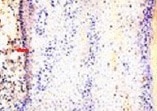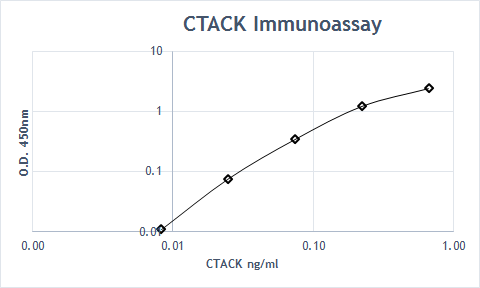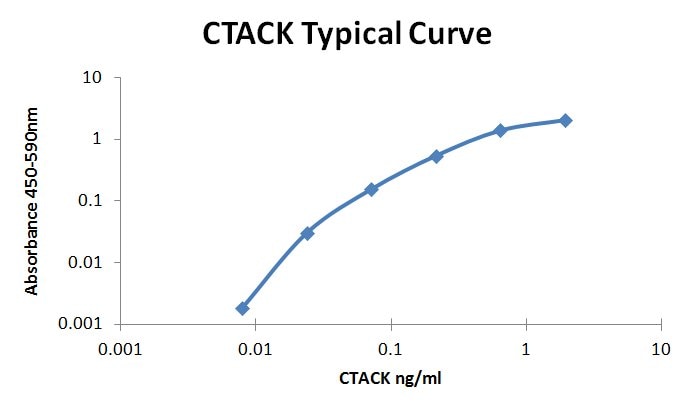Human CCL27/CTACK Antibody Summary
Phe25-Gly112
Accession # NP_006655
Applications
Please Note: Optimal dilutions should be determined by each laboratory for each application. General Protocols are available in the Technical Information section on our website.
Scientific Data
 View Larger
View Larger
Chemotaxis Induced by CCL27/CTACK and Neutralization by Human CCL27/CTACK Antibody. Recombinant Human CCL27/CTACK (Catalog # 376-CT) chemoattracts the BaF3 mouse pro-B cell line transfected with human CCR10 in a dose-dependent manner (orange line). The amount of cells that migrated through to the lower chemotaxis chamber was measured by Resazurin (Catalog # AR002). Chemotaxis elicited by Recombinant Human CCL27/CTACK (1 µg/mL) is neutralized (green line) by increasing concentrations of Mouse Anti-Human CCL27/CTACK Monoclonal Antibody (Catalog # MAB376). The ND50 is typically 0.5-3.0 µg/mL.
 View Larger
View Larger
CCL27/CTACK in Human Skin. CCL27/CTACK was detected in immersion fixed paraffin-embedded sections of human skin using Mouse Anti-Human CCL27/CTACK Monoclonal Antibody (Catalog # MAB376) at 25 µg/mL overnight at 4 °C. Tissue was stained using the Anti-Mouse HRP-DAB Cell & Tissue Staining Kit (brown; Catalog # CTS002) and counterstained with hematoxylin (blue). Specific staining was localized to cytoplasm in keratinocytes. View our protocol for Chromogenic IHC Staining of Paraffin-embedded Tissue Sections.
Reconstitution Calculator
Preparation and Storage
- 12 months from date of receipt, -20 to -70 °C as supplied.
- 1 month, 2 to 8 °C under sterile conditions after reconstitution.
- 6 months, -20 to -70 °C under sterile conditions after reconstitution.
Background: CCL27/CTACK
CCL27, also known as CTACK (cutaneous T cell-attracting chemokine), ALP, ILC, and ESkine, is a member of the CC family of chemokines (1). Mature human CCL27 is an 88 amino acid (aa) protein that shares 57% aa sequence identity with mouse and rat CCL27 (2). It shares 11%‑35% aa sequence identity with other human CC chemokines. An alternately spliced form of mouse CCL27, known as PESKY, is localized to the nucleus and promotes cellular migration (3). CCL27 is constitutively expressed by keratinocytes and is up‑regulated by inflammatory stimuli and in wounded skin (4‑7). CCL27 binds the chemokine receptor CCR10, glycosaminoglycans in the extracellular matrix, sulfated tyrosine residues on PSGL-1, and determinants on the surface of fibroblasts and endothelial cells (5, 7‑9). CCL27 cooperates with CCL17/TARC in inducing the migration of cutaneous lymphocyte antigen (CLA) positive memory T cells to the skin during inflammation (4, 6, 10‑12). Endothelial cell-bound CCL27 can mediate the adhesion of those cells to CLA+ T cells (6). CCL27 also induces the migration of keratinocyte precursors from bone marrow to the skin, thereby promoting wound healing (7). In humans, serum CCL27 levels are elevated and correlate with disease severity in atopic dermatitis, psoriasis vulgaris, and mycosis fungoides (13‑15).
- Kunkel, L. and E.C. Butcher (2002) Immunity 16:1.
- Ishikawa-Mochizuki, I. et al. (1999) FEBS Lett. 460:544.
- Gortz, A. et al. (2002) J. Immunol. 169:1387.
- Morales, J. et al. (1999) Proc. Natl. Acad. Sci. 96:14470.
- Homey, B. et al. (2000) J. Immunol. 164:3465.
- Homey, B. et al. (2002) Nat. Med. 8:157.
- Inokuma, D. et al. (2006) Stem Cells 24:2810.
- Jarmin, D. et al. (2000) J. Immunol. 164:3460.
- Hirata, T. et al. (2004) J. Biol. Chem. 279:51775.
- Vestergaard, C. et al. (2004) Exp. Dermatol. 13:551.
- Reiss, Y. et al. (2001) J. Exp. Med. 194:1541.
- Soler, D. et al. (2003) Blood 101:1677.
- Kakinuma, T. et al. (2003) J. Allergy Clin. Immunol. 111:592.
- Hijnen, D. et al. (2004) J. Allergy Clin. Immunol. 113:334.
- Fujita, Y. et al. (2006) Clin. Cancer Res. 12:2670.
Product Datasheets
Citations for Human CCL27/CTACK Antibody
R&D Systems personnel manually curate a database that contains references using R&D Systems products. The data collected includes not only links to publications in PubMed, but also provides information about sample types, species, and experimental conditions.
6
Citations: Showing 1 - 6
Filter your results:
Filter by:
-
Recruitment and significance of Th22 cells and Th17 cells in malignant ascites
Authors: XW Yang, HX Jiang, R Lei, WS Lu, SH Tan, SY Qin
Oncol Lett, 2018-08-16;16(4):5389-5397.
-
CCL27/CCL28-CCR10 CHEMOKINE SIGNALING MEDIATES MIGRATION OF LYMPHATIC ENDOTHELIAL CELLS
Authors: T Karnezis, R Farnsworth, NC Harris, SP Williams, C Caesar, DJ Byrne, P Herle, ML Macheda, R Shayan, YF Zhang, S Yazar, SJ Takouridis, C Gerard, S Fox, MG Achen, SA Stacker
Cancer Res., 2019-02-01;0(0):.
Species: Human, Xenograft
Sample Types: Whole Cells, Whole Tissue
Applications: IHC-P, Neutralization -
Glatiramer Acetate, Dimethyl Fumarate, and Monomethyl Fumarate Upregulate the Expression of CCR10 on the Surface of Natural Killer Cells and Enhance Their Chemotaxis and Cytotoxicity
Authors: Zaidoon Al-Jaderi
Front Immunol, 2016-10-19;7(0):437.
Species: Human
Sample Types: Whole Cells
Applications: Granzyme B Activity -
Serum and tissue CTACK/CCL27 chemokine levels in early mycosis fungoides may be correlated with disease-free survival following treatment with interferon alfa and psoralen plus ultraviolet A therapy.
Authors: Goteri G, Rupoli S, Campanati A, Zizzi A, Picardi P, Cardelli M, Giantomassi F, Canafoglia L, Marchegiani F, Mozzicafreddo G, Brandozzi G, Stramazzotti D, Ganzetti G, Lisa R, Simonetti O, Offidani A, Federici I, Filosa G, Leoni P
Br. J. Dermatol., 2012-05-01;166(5):948-52.
Species: Human
Sample Types: Whole Tissue
Applications: IHC-P -
Human basal cell carcinoma is associated with Foxp3+ T cells in a Th2 dominant microenvironment.
Authors: Kaporis HG, Guttman-Yassky E, Lowes MA, Haider AS, Fuentes-Duculan J, Darabi K, Whynot-Ertelt J, Khatcherian A, Cardinale I, Novitskaya I, Krueger JG, Carucci JA
J. Invest. Dermatol., 2007-05-17;127(10):2391-8.
Species: Human
Sample Types: Whole Cells
Applications: ICC -
Presence of circulating CCR10+ T cells and elevated serum CTACK/CCL27 in the early stage of mycosis fungoides.
Authors: Sasaki M, Honda A, Furuichi M, Norisugi O
Clin. Cancer Res., 2006-05-01;12(9):2670-5.
Species: Human
Sample Types: Whole Tissue
Applications: IHC-P
FAQs
No product specific FAQs exist for this product, however you may
View all Antibody FAQsReviews for Human CCL27/CTACK Antibody
Average Rating: 5 (Based on 3 Reviews)
Have you used Human CCL27/CTACK Antibody?
Submit a review and receive an Amazon gift card.
$25/€18/£15/$25CAN/¥75 Yuan/¥2500 Yen for a review with an image
$10/€7/£6/$10 CAD/¥70 Yuan/¥1110 Yen for a review without an image
Filter by:





